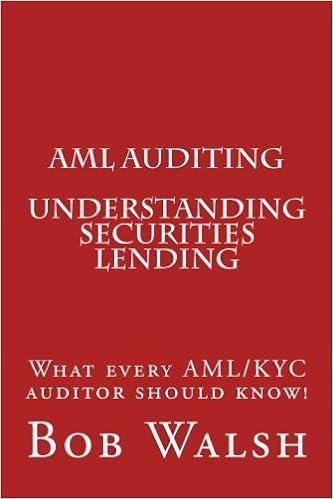Answered step by step
Verified Expert Solution
Question
1 Approved Answer
Multiple Choice 1) On December 15 of the current year, Conrad Accounting Services signed a $40,000 contract with a client to provide bookkeeping services to
Multiple Choice
1) On December 15 of the current year, Conrad Accounting Services signed a $40,000 contract with a
client to provide bookkeeping services to the client in the following year. Which accounting principle
would require Conrad Accounting Services to record the bookkeeping revenue in the following year and
not the year the cash was received?
Going-concern assumption.
Monetary unit assumption.
Revenue recognition principle.
Business entity assumption.
Cost principle.
2) On January 1, a company purchased a five-year insurance policy for $1,800 with coverage starting
immediately. If the purchase was recorded in the Prepaid Insurance account, and the company
records adjustments only at year-end, the adjusting entry at the end of the first year is
Debit Insurance Expense, $360; credit Prepaid Insurance, $360.
Debit Prepaid Insurance, $1,440; credit Insurance Expense, $1,440.
Debit Prepaid Insurance, $1,800; credit Cash, $1,800.
Debit Prepaid Insurance, $360; credit Insurance Expense, $360.
Debit Insurance Expense, $360; credit Prepaid lnsurance, $1,440.
3) Prior to recording adjusting entries, the Office Supplies account had a $359 debit balance. A physical
count of the supplies showed $105 of unused supplies available. The required adjusting entry is:
Debit Office Supplies $254 and credit Office Supplies Expense $254.
Debit Office Supplies $105 and credit Offhce Supplies Expense $105.
Debit Office Supplies Expense $105 and credit Office Supplies $105.
Debit Ofhce Supplies $105 and credit Supplies Expense $254.
Debit Office Supplies Expense $254 and credit Office Supplies $254.
4) The approach to preparing financial statements based on recognizing revenues when they are earned
and matching expenses to those revenues is:
Cash basis accounting
Accrual basis accounting
Revenue basis accounting
The time period assumption
The matching principle
5) Revenue is properly recognized:
When the customer makes an order.
Only if the transaction creates an account receivable.
When cash from a sale is received.
Upon completion of the sale or when services have been performed and the business obtains the right to collect the sales price.
At the end of the accounting period.
6) The Superior Company acquired a building for $500,000. The building was appraised at a value of
$575,000.The seller had paid $300,000 for the building 6 years ago. Which accounting principle would require Superior to record the building on its records at $500,000?
Business entity assumption.
Cost principle.
Monetary unit assumption.
Revenue recognition principle.
Going-concern assumption.
7) The accounting concept that requires every business to be accounted for separately from other business
entities, including its owner or owners is known as the:
Time-period assumption.
Revenue recognition principle.
Business entity assumption.
Going-concern assumption.
Cost principle.
8) The accounting process begins with:
Analysis of business transactions and source documents.
Preparation of the trial balance.
Presentation of financial information to decision-makers.
Summarizing the recorded effect of business transactions.
Preparing financial statements and other reports.
9) The record of all accounts and their balances used by a business is called a:
Book of original entry
Ledger
Journal
General Journal
Balance column journal
10) The rule that requires financial statements to reflect the assumption that the business will continue
operating instead of being closed or sold, unless evidence shows that it will not continue, is the:
Business entity assumption
Objectivity principle
Monetary unit assumption
Going-concern assumption
Cost Principle
11) Which of the following accounting principles prescribes that a company record its expenses incurred to generate the revenue reported?
Going-concern assumption
Consideration assumption
Matching principle
Business entity assumption
Cost principle
Step by Step Solution
There are 3 Steps involved in it
Step: 1

Get Instant Access to Expert-Tailored Solutions
See step-by-step solutions with expert insights and AI powered tools for academic success
Step: 2

Step: 3

Ace Your Homework with AI
Get the answers you need in no time with our AI-driven, step-by-step assistance
Get Started


